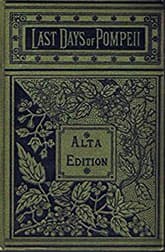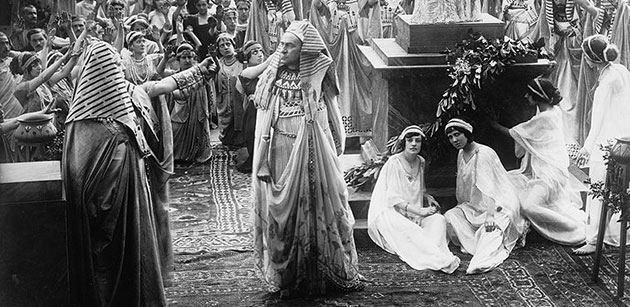The Last Days of Pompeii
Critique • Quotes • At the movies
 1851 Alta edition
1851 Alta editionFirst publication
1934
Literary form
Novel
Genres
Literary, historical fiction
Writing language
English
Author's country
England
Length
Approx. 158,500 words

Scene from the 1913 silent movie of The Last Days of Pompeii.
A spectacle made for the movies
The Last Days of Pompeii (1913): Originally called Gli ultimi giorni di Pompei; Film, 56–88 minutes; directors Mario Caserini, Eleuterio Rodolfi; writer Caserini; featuring Fernanda Negri Pouget, Eugenia Tettoni Fior, Ubaldo Stefani, Antonio Grisanti, Cesare Gani Carini, Vitale Di Stefano
Edward Bulwer-Lytton's novel of Roman drama, The Last Days of Pompeii, might not appear an appealing subject for filmmakers except for one thing: that erupting volcano, of course, that destroyed the city and covered all the petty human intrigues in retributive ash. The spectacle allowed for the creation of some of our first disaster flicks.
The explosion takes place, however, only at the end of the novel and in cinematic terms takes up only a fraction of the screen time. What to do with the rest of the story of cliché'd characters and melodramatic plot?
Most films change it drastically, with at least one of them creating entirely new characters and plot unrelated to those of the book.
Regardless of how it was tweaked though, Bulwer-Lytton's book has been repeatedly adapted, with at least half a dozen silent films (most of them made in Italy, perhaps not surprisingly) and an equal number of films produced in the sound era.
Ancient spectacle
In 1913 there were actually two films of The Last Days of Pompeii shot in Italy. The shorter one, directed by Caserini and Rodolfi, is one of the more acclaimed silent films of its time—and still scores 100-percent positive reviews by critics on Rotten Tomatoes more than a century after it came out.
It's "shorter" because the most basic version of it, free online, with Italian title cards and sporadic English subtitles is about an hour long. However, refurbished versions stretch it out to nearly an hour and a half with additional English language cards and smoothed-out action.
Long or short though, this Last Days of Pompeii follows the novel's general outline relatively faithfully, though the plot is simplified and the main cast trimmed. It's the same story of intrigue and of love lost, found and unrequited among the Pompeians.
Of course you have to make certain allowances for the exaggerated silent-film style of acting and the static camera work only once removed from stage production. And you may have a bit of trouble following the narrative if you haven't read the book but have to rely on the occasional English titles. (And in case you have problems with black-and-white movies in general, note that a remastered colorized version of the film with more comprehensive translated cards is also available now.)
The destruction of Pompeii in 1913 adaptation of The Last Days of Pompeii as a silent film
The acting standout is Fernanda Negrin Pouget, whom I've never of before but who must have been celebrated in her time and place, as the slave girl Nidia, in love with Glaucus and blind in this story. Her drama tends to overshadow the central love story of Glaucus and his Jone (as her name is styled here). And to be frank the multiply-beloved Glaucus, played by one Ubaldo Stefani, seems somewhat clueless both before and after he supposedly loses his wits due to poisoning.
The production's design, with elaborate sets and costumes, is way ahead of its time. Scenes of the city and the arena that make me wonder how they did them without digital effects. The costuming is particularly appropriate and splendid as seen in the Egyptian-style garb sported by the practitioners of the religious cult.
The highlight though, as expected, is the eruption of Vesuvius and the destruction of Pompeii. With a clever selection of restricted angles, the depiction of the terrified populace running about as boulders fall among them and columns crash upon them, with a backdrop of the ferociously spouting mountain, is incredibly realistic for its time and audiences must have been equally terrified in 1913.
B-roll of animals in the woods and burning vegetation, interspersed throughout is less successful. But that's the only part of this Last Days of Pompeii that isn't spectacular for a silent film of its time.
— Eric
Critique • Quotes • At the movies
1913, 1935

